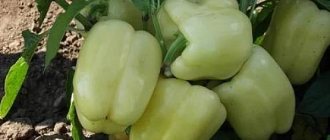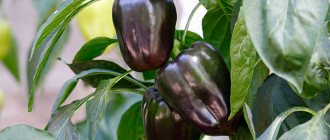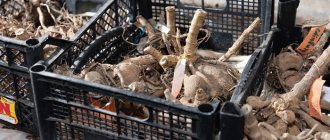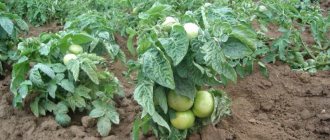According to the International Classification, border dahlias are the tallest. They grow from 60 to 150 cm and above. But in the post-Soviet space, for some reason, it is customary to call low-growing and dwarf varieties this way. Why this happened is unknown. However, landscape designers fell in love with low-growing dahlias for their beauty and unpretentiousness. Buying dwarf varieties is not so easy. They are often present in the catalogs of garden centers and online stores, but it is difficult to purchase root tubers of border dahlias - orders are placed even before the goods arrive.
Structural features of dahlias
Dahlias (Dahlia) are herbaceous plants from the Asteraceae family with a pronounced dormant period. Every year after the first frost, the above-ground part dies off, and the root tubers need several months of rest. Then the root cones are germinated and planted in the ground.
- Root tubers (root cones), which are nothing more than a thickened root and store a supply of nutrients. Thanks to them, the plant experiences a forced period of dormancy in the winter, and begins its growing season in the spring.
- The root collar is the most important organ, the lower part of the stem to which root tubers are attached. If you prune it in the fall, the growing season will not begin in the spring. It is at the base of the root collar that new stems form in the spring.
- The hollow stems are quite strong - they need to support the weight of many rather large inflorescences. However, tall varieties often need staking.
- The leaves can be pinnate or entire. Their color can be bright or dark green, or have a grayish or burgundy tint.
- The basket inflorescences consist of outer ligulate (often called petals) and inner tubular (middle) flowers. The coloring of dahlias can be the most bizarre. The shape and size of reed flowers is strikingly varied.
Features of growth and flowering of low-growing dahlias
Border varieties of dahlias, which are correctly called low-growing, dwarf, midgets or minions, are not much different from tall ones. But they are less demanding on watering and soil quality, get sick less often and tolerate unfavorable conditions better. Planting and caring for low-growing dahlias is easier.
In addition, dwarf varieties bloom earlier. The height of the plant depends on the growing conditions. A variety whose description declares the bush size to be 30 cm will easily reach 40 or even 50 cm if it is actively watered and fed. So intensive care is not advisable for border dahlias.
How do low-growing dahlias reproduce?
It is generally accepted that all low-growing dahlias are grown from seeds. This is true only for border and dwarf varieties of the Mignon and Topmix series. You can even collect your own seeds from them and sow them directly into the ground or through seedlings. But it is impossible to predict the color and shape of the flower of such a dwarf dahlia, and terry baskets can become simple.
The elite series of low-growing Melody and Gallery are propagated by tubers, just like tall varieties. Border dahlias grown from their seeds do not inherit maternal characteristics. Even if you buy seed in a store, there is no guarantee that the flower will even closely resemble the declared variety.
Any dahlias, including dwarf ones, are easily propagated by cuttings.
Cactus dahlias - class description
The group of cactus dahlias is very numerous. The entire range of colors, variety of sizes and many decorative options can be found in this group. Cactus dahlias differ in their flowering period - some varieties can bloom as early as June and continue to delight the eye with their beauty until late autumn. Among cactus dahlias there are single-colored and variegated varieties, low-growing and tall. General botanical description of the cactus dahlia class:
- the roots of the plant are oval-shaped tubers of gray color with a brownish tint;
- leaves are three or two pinnate, rich green in color;
- stems are hollow, straight, cylindrical;
- from 1 to 3 inflorescences on 1 plant;
- Feature – long petals rolled into a narrow tube.
It is thanks to this feature that cactus dahlias get their name. The narrow and long petals look like cactus spines. The inflorescences grow huge, lush, resembling needle cacti. For their growth, it is only necessary to comply with the following conditions.
- Dahlias are planted at a distance of 40-50 cm. Tubers are buried at 25-30 cm.
- The soil is loose, with neutral Ph, pre-fertilized with organic matter. Mineral supplements are added as the plant grows and develops.
- Cactus dahlias are grown from seeds or tubers. Hybrid varieties are not recommended to be propagated by seeds.
- The time for planting in open ground is the first half of May.
- The flower is fed monthly with mineral fertilizers and organic matter is added 2-3 times a season.
- The flower does not like churned, non-breathing soil and waterlogging.
Dahlias are resistant to pests and are extremely rarely attacked by insects. The flower can be protected by proximity to herbs and plants that repel them. It is also not difficult to protect a flower from diseases - it is important to follow the basic rules of agricultural technology and provide the flowers with proper care.
Reasons for the popularity of dwarf dahlias
Among the dwarf dahlia varieties, gardeners of the older generation can only remember the Merry Guys, which grew in Soviet times on almost every plot. They, of course, decorated the garden area until late autumn, pleasing the eye with a variety of colors, but nothing more. They could be called cheerful or cute, but not sophisticated or beautiful.
Only with the advent of the Gallery border variety series, which took 15 years to create, did low-growing dahlias become mega popular. In Russia and neighboring countries it is still difficult to buy planting material.
Planting dahlias of low-growing varieties has a number of advantages:
- they are easier to care for;
- dwarf varieties require less watering and fertilizing;
- border dahlias can be grown in pots, balcony boxes, flowerpots of any shape and size;
- Many dwarf varieties that bloom in containers can not be dug up, but left to winter in them by cutting off the top part and moving to a dark room with a temperature of 5-8⁰ C;
- root tubers of low-growing dahlias are small in size and tolerate waxing well;
- the small size of dwarf varieties makes it easy to find a place for them on the site;
- in changeable autumn weather, when frost gives way to warm weather, low-growing dahlias do not have to be retired: you can cover them with agrofibre or temporarily bring the container indoors;
- modern dwarf varieties can have large double inflorescences and are very beautiful;
- low-growing dahlias bloom earlier than tall ones.
How to plant dahlias
Selecting and preparing a site for placing dahlias
Requires sunny, well-warmed and protected from the wind places, does not tolerate stagnant moisture.
It prefers medium-loamy garden soils rich in humus with a neutral reaction; it also develops well on sandy soils generously fertilized with organic matter.
If groundwater comes close to the surface of the earth, a raised bed for dahlias is arranged, filling up hills or ridges 20-30 cm high. It is convenient to fence the edges of the ridges with boards and braid them with branches. Drainage is added to the bottom of the planting hole - a layer of crushed stone, expanded clay, sand.
Before planting the dahlia, pour into one planting hole:
- 2-4 kg of well-rotted manure or compost,
- 20 g superphosphate,
- 15 g potassium nitrate,
- 10 g of potassium sulfate.
Some gardeners are not afraid to add fresh horse manure, up to a third of a bucket, into the hole right before planting dahlia roots. Horse manure does not burn the roots of the plant and provides the roots with the necessary substances.
Good soil permeability is especially important for perennial dahlias that form tubers. Annual varieties are not so demanding on soil structure.
Some gardeners plant dahlias in flower beds made from car tires. At the bottom of the planting holes, drainage is poured in the form of a layer of crushed stone and sand, at least 10 cm thick.
Recommendations for crop rotation:
Due to similar diseases (fusarium), dahlias are not placed near or after asters, tomatoes, peppers and potatoes. Also, do not place dahlias in the same place for several years. After flowers, it is useful to improve the soil by sowing green manure, for example, lupine.
Inspection and preparation of planting material
After winter storage, dahlia planting material is inspected. If pockets of rot are found on the tubers, the entire affected part of the tuber is cut off. Use a sharp, clean knife or scalpel. The cut must be treated with crushed charcoal or coated with brilliant green. The treated tuber is allowed to dry so that the cut is ventilated.
If the dahlia segment is large, it can be divided into parts. The rhizome is cut with a knife so that a part of the stem with growth buds remains on each tuber. The sections are disinfected with brilliant green and sprinkled with coal or ash.
Some gardeners, wanting to get dahlias to bloom earlier, germinate the tubers at home. Detailed information:
Germination of dahlia tubers after winter
How dahlia tubers are treated before planting:
- light pink solution of potassium permanganate, soaking for half an hour;
- phytosporin, diluting it in water according to the instructions.
These solutions will protect the tubers from the development of fungal diseases and kill the infection. To speed up the awakening of the flower and active growth, it is useful to soak the tubers in the root.
If the tubers are overdried, they are soaked in a solution of Epin or Heteroauxin for several hours.
Useful video: How to choose a dahlia and prepare it for planting
Planting dahlias with tubers in spring
The timing of planting flowers depends on the climate of the region. Dahlia tubers are planted when the soil warms up to +10 degrees at a depth of 12-15 cm. In the middle zone, flowers are planted in the middle or end of May. A slight cold snap will not harm the tubers sitting in the ground.
Sprouted tubers and seedlings are planted when the threat of frost has passed. The delicate foliage of dahlias dies at temperatures as low as 0 degrees. Plants can be protected by constructing shelters made of arcs and film over the plantings.
When to soak dahlia tubers before planting if they have not been germinated?
It is necessary to treat plants with a disinfectant and stimulating solution several hours before planting.
Holes for planting dahlias with tubers in the spring are dug such that the tubers are placed entirely and there is room for adding humus and drainage. For tall varieties, a support is immediately installed in the center of the pit. Driving a stake into the soil after planting a dahlia can easily damage the roots of the plant.
A dahlia section is placed in a hole and covered with soil, covering the root collar a couple of centimeters. Covering the root collar with soil in a thick layer can lead to rotting of the plant! After planting, pour plenty of water and add soil if necessary. The surface of the earth around the bush is mulched with humus, shavings, and tree bark.
Flower seedlings are planted without burying the stem in the soil and trying not to destroy the earthen ball.
The distance between dahlia bushes depends on the size of the future plant:
- low-growing varieties are placed according to a 30 by 40 cm pattern,
- tall and lush varieties - 50 by 70 cm.
From an aesthetic point of view, dahlias do not look good next to roses. Lush flowering plants will compete with each other.
Varieties of low-growing dahlias with photos and names
Photos of low-growing varieties of dahlias cannot fully show their beauty. This primarily applies to the Gallery and Melody series. The ease of planting and caring for dwarf dahlias has made their varieties a decoration not only for gardens and flower beds. They are planted on terraces, balconies, and in flowerpots decorating the entrance to the house.
A series of varieties of low-growing dahlias Gallery
The Dutch variety series of low-growing dahlias Gallery, which breeder Viewer created for 15 years, is distinguished by large double inflorescences with a diameter of 10-12 cm and small bushes - 25-40 cm. Strong, tall peduncles allow them to be used as cut flowers. Many varieties of border dahlias in this series are named after brilliant artists. The series was created specifically for growing in containers.
Art Deco
The Art Deco border variety was registered in 1994 and classified as an ornamental dahlia. With proper care, the bush will be short - up to 40 cm, the leaves are green. The diameter of the double inflorescence-basket is about 12 cm. The outer side of the reed flowers is orange-brick, the inner side is terracotta. The buds open at the end of May and form before frost.
Leonardo
The border dahlia Leonardo was created in 1994, according to the International classification it belongs to the decorative varieties. The bush is dwarf, up to 35 cm. The basket-inflorescence reaches a diameter of 15 cm. The ligulate marginal flowers are salmon pink, with pointed tips. The small convex center and bases of the petals are yellow. Flowering is long-lasting, abundant and spectacular.
The dwarf dahlia variety Monet was bred in 1999. It belongs to the decorative group. The bush is short - up to 30-60 cm, depending on the intensity of care and the size of the root tuber, the leaves are dark green. Inflorescences-baskets with a diameter of 10-12 cm form milky white, pale purple at the tips, slightly curved reed flowers. These border dahlias cannot withstand temperatures down to -5⁰ C for long.
La Tour
The dwarf dahlia La Tour, created in 2007, amazes not only with the beauty of the flower, but also with the color of the leaves. It is classified as a variety of the decorative group. The bush grows up to 45 cm, the leaves are green, with a burgundy tint. The inflorescence-basket is 12 cm, but there is evidence that there is a sport (a plant with characteristics different from the varietal description) with a diameter of up to 20 cm. The reed flowers are a delicate pink-violet color, rich at the tips, and light at the base.
Riviera
The low-growing variety Rivera is similar to spherical dahlias, but belongs to the group of decorative ones, so it forms a hemisphere. The bush is dwarf, up to 40 cm tall, with dark green leaves. The basket-inflorescence consists of flowers that are flat along the edge, closer to the reeds, and have a rich red color.
Vermeer
The border variety Vermeer was developed in 1994 and is classified as an ornamental variety. The bush is dwarf, 40 cm high, lush, strongly branched, with dark green leaves. A double inflorescence-basket with a diameter of up to 10-15 cm consists of light orange reed flowers that form a sphere that is not completely closed. The bush requires rationing of the load or increased nutrition, since it forms a lot of buds. Flowering begins in early summer and continues until the first frost.
Types of dahlias
Dahlia stems, due to their strength, were used as drains and pipes supplying water. With the advent of the conquistadors and the expeditions of the Venetians, flowers came to Europe. And their original name was Dalia. In honor of the famous scientist Dahl. But dahlias arrived in Europe not as flowers, but as vegetables. Only after some time this error was corrected. Having passed this way, the flowers are now developing in the wind near architectural monuments, delighting people passing by.
Thanks to a large number of experiments related to crossing and breeding new varieties, thousands of dahlia varieties are known today.
Differing from each other in the structure of the stem and inflorescences, the type of bushes and petals, dahlias are divided into 14 main groups, after reading whose names, it becomes clear which flower belongs to which:
- Nymphaeaceae.
- Anemone-like.
- Collared.
- Peony-shaped.
- Pompons.
- Cactus.
In the color scheme you can find both white and burgundy, blue and purple inflorescences. Among them there are a large number of mixed colors. Today, varieties with variegated leaves, as well as multi-colored varieties, are very popular.
For ease of classification, three factors have been identified by which dahlias can be identified as one or another variety: the shape of the inflorescence, the height of the plant and the dimensions of the bush.
In the “height” factor, it is customary to distinguish three groups:
- No more than 70 centimeters (low).
- No more than 120 centimeters (average).
- No more than 125 centimeters (high).
Flower size also includes three groups:
- Up to 10 centimeters (low-flowered).
- Up to 20 centimeters (medium-flowered).
- From 20 centimeters (large-flowered).
The shape of the inflorescence unites most varieties into one group - decorative flowers. That's what they are called. But there are also individual types:
- Collared.
- Cactus.
- Pompons.
Another boring name for these flowers is border flowers. They have become familiar to the eye and can be seen most often.
Among them, the most popular are:
- "Blusette" is a plant with a light plum-colored flower.
- "Margareth Cleene" - having a salmon-colored flower, it translates as Margaret - baby.
- “Berliner Cleene” is a flower with a delicate pink color, translated as “Berliner baby”.
All these species begin to bloom in mid-July, and another common feature is the moderate brightness of the color of the inflorescences. Some even prefer to call it a “pastel” color.
In order for these flowers to begin blooming a week or even two weeks earlier, it is necessary to grow the rhizomes of these plants. For this purpose, special peat soil is used. You can also use wet sand. The main thing is to take into account the flowers’ fear of cold weather. Hence the need arises before planting them to make sure that all the cold has passed and will not return again. Or protect the plants from contact with cold weather using a plastic bag, thereby covering them. Another fairly durable material will also work. The main thing is that it does not consist of fabric.
The rhizomes make themselves known within a week if they are germinated.
If not, then in two weeks. These varieties are grown in large quantities in Holland and are in extraordinary demand. The average height of the stem together with the flower is considered to be from 30 to 40 centimeters.
Another famous variety of dahlias can be safely called “Gallery”. This series is extremely popular among both the most sophisticated and novice gardeners. The series includes such varieties as:
- "Gallery Art Deco".
- "Gallery Rembrandt".
- "Gallery Singer".
- "Gallery Bellini" etc.
Planting and caring for border dahlias
Border dahlias, the varieties and photos of which were presented in the article, require less care than tall ones - they do not need to be tied up, and it is not necessary to pinch them. It’s just that if you cut off the top, the bush will branch better.
The varieties of border dahlias Mignon and Topmix can be grown through seedlings or by sowing in the ground. It is not recommended to loosen them. Dwarf dahlias need to be watered and fed sparingly. The better care they take, the faster the green mass grows, but fewer flowers are formed.
Dwarf varieties are planted in a sunny place. If you remove faded inflorescences in time, new buds will form faster and in larger quantities.
At the end of the season, even border varieties grown from dahlia seeds develop root cones. They do not have to be thrown away along with the soil. You can dig it up and store it in a dark place at a temperature of 5-8⁰ C, or put the pot in such conditions by cutting off the above-ground part.
Storage
Tubers are dug up in the fall, but before major frosts. It is better to do this towards the end of September or beginning of October. Store indoors at a temperature of 3 to 7 degrees and a humidity of about 80%. You can place the tubers in sand or peat.
Read about propagation and care of fuchsia in this useful article.
Caring for plumeria at home will become easier by following these tips.
Ktenanta will please the gardener, https://sad-doma.net/houseplants/decorative-leaf/ekzoticheskaya-ktenanta-uhod.html if you follow the rules for caring for it at home.
Growing low-growing dahlias in flowerpots
Dwarf dahlias Mignon and Topmix can be sown directly into containers or seedlings can be planted there. The soil chosen is moderately fertile and loose. Drainage must be placed at the bottom. Border variety series Melody and Gallery are planted with sprouted root tubers.
The main thing when growing low-growing dahlias is to maintain proper watering. Over-watering will not benefit the crop, and the root cones may rot. At the same time, the soil in pots can quickly dry out in hot weather and the flower will die.
It is best to fertilize the crop in containers with fertilizers specifically designed for dahlias. The instructions must be followed exactly.
Preparing for winter
Cactus dahlias are usually dug up at the end of September. For this, it is best to choose a dry day. In this case, the tubers will be able to dry out, which will extend their shelf life.
Using a knife, you need to cut the flowers at a height of 10 cm from the ground. Cover the cut bushes with foil and dig around them on all sides. Use a pitchfork to remove a lump of tuber from the ground, wash it with water and place it in a solution of potassium permanganate for half an hour.
Then the tubers need to be dried, this will take at least 8 hours. After this, they can be stored. Tubers should be stored in boxes with pine sawdust placed at the bottom. In addition, you can use a bag, box, or newspaper to store dahlias.
Reasons for the popularity of border dahlias
Low-growing dahlias are often called border dahlias. However, in this case this is not entirely true. Usually the term “border” is applied to plants with a height of 0.6 m, but low-growing dahlias do not reach these values. The average height of these plants is 0.3-0.5 m. This quality allows you to grow low-growing dahlias as potted plants. This is what caused the sharp increase in their popularity. Thanks to breeding work, the varietal diversity of these flowers has increased significantly in recent years, which has affected their popularity.
Another reason for the growing interest in border dahlias is the relatively simple agricultural technology for growing them. Such varieties require less care, while they are much less likely to get sick and are more resistant to adverse weather conditions.
Varieties of low-growing dahlias
There are quite a few varieties of border dahlias. Currently, breeding work in this direction is being carried out quite actively, so the varietal diversity of these flowers is increasing every year.
Series of low-growing dahlias Gallery
Gallery is the result of crossing border and wild low-growing species. The first varieties of this series were obtained in 1994 in the Netherlands. A distinctive feature of all dahlias included in this series is a completely double inflorescence of a rather large size - up to 15 cm. At the same time, the height of the bushes can be only 40 cm.
Art Deco
The inflorescence of this variety is very bright, orange-red. Visually it looks like it is illuminated from the inside.
The size of the bush varies between 30-40 cm, the diameter of the inflorescences is 10-15 cm.
Leonardo
Bushes of the Gallery Leonardo variety grow up to only 20 cm, while the diameter of the flower cap can reach up to 10 cm.
The flowers are pale pink, the color of the petals at the base changes from dark pink to yellow. The variety is undemanding to care and stands out well when cut.
Bushes of the Gallery Monet variety can grow up to 0.4 m. The average size of inflorescences is 10-12 cm.
The color of the petals is white, yellowish at the base, with a pinkish-purple edge at the tips.
La Tour
Low-growing border dahlia bushes La Tour are excellent for decorating flower beds; they can be used to decorate terraces and balconies. The height does not exceed 0.3 m. The size of the inflorescences is 10 cm.
The color of La Tour's petals is pinkish-white, with lilac on the periphery.
Riviera
The Riviera variety is one of the most spectacular in the Gallery series. The flowers of this low-growing dahlia are bright red and look great in bouquets and plantings.
The bushes are very compact, no more than 0.3 m high.
Cobra
The Gelleri Cobra variety is well suited for growing in flowerpots, pots or containers. This border dahlia is a low, compact shrub. Its height can be 0.4-0.45 m, the diameter of the flower cap is 12-14 cm.
The inflorescences are orange-red and bright. Well suited for decorating bouquets.
Series of low-growing dahlias Melody
This “musical” variety of border dahlias was developed in the Netherlands at the beginning of this century. Compared to Gallery, Melody bushes are taller; most varieties of this series have a height of 0.5-0.55 m. The inflorescences are completely double, 10-12 cm in diameter.
Fanfare
Dahlias Melody Fanfar grow in a neat bush up to 0.5 m high. The inflorescences are bright lilac, the middle of the flower is yellow.
The variety is characterized by long flowering, unpretentiousness and ease of care.
Allegro
The Melody Allegro variety forms a compact bush about 0.6 m high. Flower caps can reach a diameter of 10 cm, and with good care - up to 12 cm.
The pink petals of this border dahlia have a yellow base and a slight lilac edge.
Mambo
Melody Mambo dahlias bloom from July to October. The inflorescences of this variety are 10-12 cm in size. They are a rich burgundy color, darker in the center of the flower.
The border dahlia bush Melody Mambo grows up to 0.5 m. It is compact, even, and does not need pinching or shaping.
Harmony (Harmony)
The flowers of the dahlia variety Melodies Harmony have milky white petals, gradually turning into pink with a lilac tint.
Bushes of this variety of border dahlias grow up to 0.5 m.
Border dahlias Melody Dora can grow up to 0.6 m. The diameter of their inflorescences can reach up to 15 cm. Flowering is long, continuous, July-October.
The coloring of the dahlia Melody Dora is very impressive. At the base the petals are yellow, closer to the periphery the color changes to brick pink.
Series of low-growing dahlias Topmix
Border dahlias of the Topmix series are distinguished by their small height; the average size of a bush usually does not exceed 0.3 m. The flowers are flat, non-double, with numerous yellow tubes in the center. Flowering is long and abundant.
Yellow
Dahlia Topmix Yellow grows into a lush, dense bush no more than 0.25 m high. The shoots are numerous, strong, and even. The foliage is high.
It blooms profusely and for a long time, from July to September. Suitable for borders and single plantings. Grows well in flowerpots and containers.
Vin Red
Vin Red dahlias are widely used to decorate flower beds and home areas. The bush is not tall, it can grow up to only 0.25 m.
The flower is flat, single-row, with wide outer petals. The color is bright red, in the center there are numerous yellow tubes.
Sweetheart
The petals of the border dahlia Sweetheart are bicolored, white at the base and lilac-pink at the tips. The bush is low, up to 0.3 m, compact, with numerous shoots.
Dahlia Sweetheart blooms constantly and abundantly, from July to September.
Series of low-growing dahlias Mignon
Mignon is a series of low annual border dahlias. Thanks to the seed propagation method, they do not require winter storage of tubers.
Funny boys
With good care, the bush of the Merry Guys variety can grow up to 0.6 m, although it usually does not exceed 0.3 m. The shoots are numerous, even, and the foliage is strong.
The flowers are flat, non-double, with numerous yellow tubes in the center. The coloring is varied.
Figaro
The dahlia Figaro variety is widely used as border plants, and is also used for growing on terraces and balconies.
The bushes of this variety of border dahlias grow up to 0.35 m. The flowers are large, up to 10 cm.
Varieties of border dahlias for planting in flowerpots
Almost all varieties of border dahlias are suitable for growing dahlias in pots, pots or containers. Typically, flower growers and landscape designers in this case are guided not by the possibility of growing, but by the decorative component, i.e., the color, size and shape of the flower bush. For planting in large flowerpots, it is preferable to use low-growing border varieties from the Gallery series, since their double flowers look more decorative compared to Mignon or Topmix.
Currently, there is a whole group of low-growing dahlias, which combines varieties grown primarily in flowerpots or containers. These are the so-called pot dahlias (from the English “pot” - pot). These are large-flowered plants with a bush height of about 0.3 m. These dahlias include the following varieties:
- Alstergruss.
- Art News.
- Art Fair.
- Virginia.
- Ohio.
- Pablo.
- Renoir.
Containers with flowers can be placed outdoors in the spring, putting them indoors at night. You can do the same in the fall. Thanks to this, you can significantly increase the flowering time of these plants.
Planting low-growing varieties on the site
Border dahlias are planted in the ground when stable positive night temperatures appear and return frosts are completely avoided. In central Russia this is the end of May. In the Volga region, closer to the Volgograd reservoir, dahlias can be planted in the ground in mid-May.
Choosing a landing site on the site
All types of dahlias are light-loving, so the most successful solution would be to place future bushes in the sunniest area.
Dwarf varieties are container varieties, so the containers are selected in such a way that there is at least 5 liters of soil per plant. Drainage must be good so that water does not stagnate in the flowerpots and air can freely penetrate to the roots.
The choice of soil is determined by the requirements of low-growing dahlias. The main criteria for suitable soil are looseness and moisture permeability. To achieve these important indicators, it is necessary to take into account the quality of the existing soil in order to add the necessary elements before planting.
So, the composition of the soil for a low-growing dahlia may include:
- river sand;
- gravel;
- perlite;
- peat;
- fine expanded clay.
River sand is an excellent loosening agent for clay soils, gravel improves air permeability, perlite and peat help retain moisture, and fine expanded clay plays the role of drainage.
Before planting, you can add and mix with the soil a small amount of rotted (!) manure and about 100 g of wood ash (per 5 liters of soil). If the soil contains a lot of sand, then to improve the quality of flowering, boron and zinc are added before planting (can be included in mineral fertilizers).
Rules for growing low-growing dahlias
There are three ways to propagate dwarf varieties:
- tuber division;
- sowing seeds;
- cuttings
It is most effective to propagate low-growing dahlias by dividing the tubers. In the fall, the tubers are dug up, carefully shaken off the ground, and the nests of the tubers are separated with a clean knife or hands. Each plot should have a root collar and several buds left. If you do not divide them into separate tubers, then after 5-6 years the plant degenerates, losing varietal characteristics and decorative qualities. The sections are sprinkled with charcoal and stored in a dark, cool and dry place until spring.
For early flowering tubers, plants are planted individually in pots, one-third filled with light floral substrate containing peat. If you save space and containers, the overgrown roots will become tangled between neighboring flowers, and this can cause damage to the root system when planted in the ground. To prepare plants for planting, a fairly long period of tuber awakening and sprouting is required. At this time, the pots can be placed in any warm place in the apartment. In the future, to avoid pulling out the hatched sprouts, it is necessary to choose a warm and bright place. If this is a window sill, then it is preferable to place the pots on the south or south-east windows. If you do not germinate tubers at home, flowering occurs much later, approximately in the second half of July.
The seeds germinate fairly quickly 4-5 days after sowing. For greater germination, containers with sown seeds are covered with glass or transparent film, after germination they begin to ventilate, gradually increasing the time without covering. This method of propagation is used less often than others, because flowering when sowing seeds occurs only 90-100 days after sowing, and the preservation of the varietal characteristic is not always guaranteed.
For propagation of dwarf dahlia by cuttings, a summer growing season is expected. It is necessary to cut young shoots no more than 10 cm high. The cuttings are planted in soil with a high content of river sand and covered with a transparent film. After two weeks, the root mass builds up and the plants continue to grow. In the first days, shoots can be shaded during the midday hours. The benefits of cuttings are noticeable in larger inflorescences and complete preservation of varietal characteristics.
Flower care
There are no fundamental differences from caring for tall varieties; the difference is noticeable only in less water and fertilizer. It is necessary to feed with caution; it is advisable to exclude organic matter (except for spring application).
Attention! Organic matter promotes green growth by slowing down and reducing flowering.
You may be interested in: When to dig up dahlias in the fall: types of flowers When to dig up dahlias in the fall and how to store until planting in the spring? The most favorable days according to the lunar sowing calendar for germinating annual dahlias
It is preferable to replace loosening with mulching. This will eliminate the appearance of weeds and improve soil permeability. It is better to remove faded inflorescences in a timely manner, then the bush of border dahlias becomes strewn with bright flowers.
Watering is necessary regular and moderate.
When the first frost occurs, the containers can be brought to a warm place. When the capricious autumn brings back the warmth again, the bushes are put outside again, and flowering continues.
Features of planting dwarf dahlias
Dwarf dahlias need a well-lit place; in the shade the plants bloom much worse. The area must be protected from the wind. Loose, breathable soil is well suited for dahlias. In this case, the area should not be swampy; excess groundwater in the soil will cause rotting of the rhizomes.
Tubers are planted in open ground in mid-May, when the soil is warm enough. Planting in flowerpots or containers can be done much earlier. Sprouted plants are planted in open ground with the root collar deepened to the 1st internode. It is advisable to add humus and wood ash to the soil with which the planting hole is filled. If the soil is not loose enough, you need to add sand to it.
After planting, the plants are watered abundantly and the root zone is mulched with peat. If the air temperature drops significantly at night, then at first young plants can be covered with cut plastic water containers.
A video about planting low-growing dahlias can be viewed at the link:
Winter storage
Dahlias, whether tall or those that do not reach 40 centimeters in height, are not allowed to overwinter in the ground under our weather conditions. With the arrival of the first cool nights, that is, in early September, the soil is usually mulched with sawdust. This is done to save the tubers from hypothermia. Dig up dahlia bushes after the stems and leaves of the plants droop and darken. This occurs around the middle or end of October. Before removing the bushes from the ground, the top of the plant is cut off, leaving about ten centimeters. You cannot pull the plant too hard, as you can damage the rhizome.
Advice : if the root system is damaged, then the “wounds” need to be treated with a composition of chalk and charcoal.
It is recommended to divide the tubers before harvesting for storage. This is necessary so that the plant saves energy for growing large tubers in the new season. If you plant dahlias with whole tubers in the spring, they will give birth to very small offspring that will grow and bloom poorly.
Caring for dwarf dahlias
Border dahlias are low maintenance. Regular watering is required for normal growth and abundant flowering. In hot weather, this can be done 3-4 times a week; in the presence of precipitation, the frequency of watering can be reduced. It is imperative to loosen the soil in the root zone; it must be breathable. In this case, mulching helps well; it not only retains moisture in the soil, but also maintains the porosity of the soil, preventing the formation of a crust on the surface. In addition, mulch prevents weeds from growing.
How to care for dahlias Merry guys
Caring for the crop consists of timely watering, periodic fertilizing, loosening the soil, and trimming faded buds. For prevention, bushes are sprayed with insectofungicides before flowering.
Watering
Irrigate the ground under the plants once a week. Excessive moisture can lead to fungal diseases. Therefore, in case of prolonged rainfall, watering is adjusted. Annuals can withstand short-term drought.
Top dressing
The first fertilizing is done with nitrogen 2 weeks after planting. Next time they fertilize with potassium and phosphorus during the budding period. During flowering, dahlias need to be fed with organic matter. If the plants were planted in fertile soil, the first application of fertilizer is skipped.
Trimming
Cheerful guys form lush bushes on their own. A large number of buds grow on them. Therefore, these dahlias do not need to be shaped. They only require trimming of faded buds. You can pinch the top of the main stem once, and then the bushes will be even more magnificent and beautiful.
How do border dahlias propagate?
There are several propagation methods for border dahlias:
Annual low-growing dahlias can be grown from seeds. It is enough to simply collect seed material yourself from faded inflorescences of the desired variety. You can purchase seeds in specialized stores, at gardening markets, or order online.
Vegetative propagation methods are used for perennials. Dividing tubers is the easiest and most popular way to propagate these plants. This procedure is carried out before planting sprouted tubers in open ground, in the middle or at the end of spring. You need to divide the tubers carefully; growth buds should remain on each division.
Dahlia cuttings are used relatively rarely as a propagation method. This is due, first of all, to the ability to propagate these plants using a simpler method - dividing the tuber. Cuttings are obtained from sprouts produced by a sprouted tuber. Then they are treated with a solution of a root formation stimulator and planted in containers filled with a mixture of peat and vermiculite. After rooting, the seedlings are planted for growing, and then transplanted to a permanent place in open ground.
Reproduction of dwarf dahlias
Propagation of dwarf dahlias by seeds
- When purchasing dwarf dahlia seeds, be sure to pay attention to the expiration date of the planting material.
- You can sow the seeds of dwarf dahlias both in open ground and in containers and boxes for growing seedlings. Seeds are sown in the ground at the end of May. Seedlings can begin to be grown at the end of March.
- Select suitable containers for growing seedlings.
- Place a drainage layer at the bottom of the container.
- Fill the boxes with nutrient soil.
- Make holes 2-3 cm deep at a distance of 3 cm from each other.
- Before being immersed in the ground, seeds must be placed in a formaldehyde solution for 10-15 minutes for disinfection and then dried.
- Sow the seeds, cover them with soil and water.
- To make seedlings appear faster, cover the box with film or glass. Monitor the soil moisture and periodically ventilate the plantings.
- After 7-10 days, the first shoots of dwarf dahlias will appear.
- As soon as 2 leaves appear on each seedling, they can be planted in separate containers.
- At the beginning of May, the seedlings are taken outside for hardening, and at the end of May the seedlings are planted in open ground.
Propagation of dwarf dahlias by cuttings
- Cut off a strong side shoot from an adult dwarf dahlia. The cut must be made at an angle of 45 degrees.
- Next, the cutting is strengthened in the sand, covered on top with a jar, bottle or film and placed under an ultraviolet lamp.
- If the dahlia stalk is treated with any root-stimulating solution before being immersed in the ground, then root formation will occur at an accelerated pace.
- After you see the roots, the cutting can be planted in nutrient soil.
Reproduction of dwarf dahlias by tuber division
Dwarf dahlias very rarely try to propagate by dividing the tuber. The fact is that these miniature plants form tubers poorly or may not form them at all during the season. But with good care and favorable environmental conditions, tubers of sufficient size can be formed.
- Using a suitable garden tool, carefully dig up the plant and free the tubers from the earthen clod.
- The tuber is divided into several parts so that each part has roots and part of the root collar. You can either divide by hand or carefully cut with a sharp knife. The cut areas must be sprinkled with crushed coal.
- Next, the tubers are planted in prepared holes.
- After planting, dahlias must be watered. Dwarf dahlias can be propagated by dividing the tuber only once per season.
It is necessary to divide dahlia tubers not only for the purpose of propagating the plant, but also for the purpose of its rejuvenation. As a rule, large tubers quickly become unusable.
Disease and pest control
One of the reasons for the popularity of border dahlias is their excellent disease resistance. The appearance of diseases is most often associated only with violations in care, mainly with excessive watering. Under such conditions, bacterial cancer or viral mosaic may develop on the bushes. These diseases cannot be treated; affected plants must be immediately dug up and burned. When powdery mildew appears on the leaves, plants should be sprayed with colloidal sulfur.
Insect pests on border dahlias can include aphids, thrips, snails and slugs. Underground tubers can be attacked by wireworms. Pests are controlled by spraying the bushes with various means, including folk remedies, such as a solution of wormwood or celandine tincture. Treating plants with a solution of laundry soap helps against aphids and thrips.
Description of the variety and characteristics
Until recently, all varieties of dahlias were predominantly tall. However, the miracles of selection brought to light a low-growing species of dahlia.
The low-growing dahlia, or as it is often called the “border” dahlia, is a small, strong bush with good foliage. The crown of the plant is decorated with multi-colored flowers with a diameter of 10-20 centimeters. This type of dahlia is great for planting along paths and borders, which are the ideal and most popular planting locations. Can also be grown in flowerpots and at home.
Interesting : this flower was named dahlia in honor of Professor Johann Georgi Gottlieb from St. Petersburg. The dahlia is native to South America. In ancient times, the Mayan tribes consumed the flowers themselves as food, and used the thick and very strong stems as water pipes.
Low-growing dahlias can grow 30-60 centimeters in height, having inflorescences of different sizes.
The variety of varieties of low-growing dahlias is amazing. All of them have distinctive features based on the structure of the flower: there are single-row petal flowers, double, semi-double and collared. Low-growing dahlias offer a wide range of colors from bed tones to rich, bright colors. There are border dahlias that bloom at once with multi-colored, harmoniously combined flowers.
Fact : The lower the dahlias, the earlier they bloom.
Low-growing dahlias are:
- border - the height of the bush is 40-50 centimeters, forming a lush and profusely flowering bush;
- dwarf border - a bush 30-40 centimeters high; this subspecies is usually planted in the foreground of flower beds;
- dwarf potted plants - maximum height 30 centimeters. They are grown mainly in flowerpots or containers.
Fact: The height of a dahlia often depends on the composition of the soil and the conditions in which it grows.
Why has this variety of dahlia become so popular? It's all about their botanical and decorative characteristics. Few people will pass by bushes blooming in all the colors of the rainbow without paying attention to them. Low-growing dahlias are very undemanding in care, and they take root even in harsh conditions. Growing them is a joy for both experienced gardeners and beginners.
One of the undoubted advantages of low-growing flowers is the fact that they do not need to be pinched, pinched or tied up. During the growing season, dwarf plants require almost no care. Growing such flowers is a pleasant experience. By eliminating complex agricultural techniques, you can free up a lot of time for other more enjoyable activities, for example, contemplating the main decoration of the garden.
Each bush is capable of producing up to thirty small flowers, which appear by mid-summer and fall off only with the first frost.
Pros of low-growing dahlias:
- flowers bloom profusely and for a long time. If the tubers were germinated, then the dahlia blooms already in June;
- very easy to care for. The plant does not need shaping;
- The stems of the low-growing dahlia are very strong, they can withstand even a strong gust of wind and not break;
- flowers practically do not get sick and are not damaged by harmful insects;
- low-growing dahlias can be planted in any areas and flower beds, along borders and paths, as well as in flowerpots and pots. The decorative benefits are endless;
- grow well at home;
- take up little space, do not require much light;
- The tubers are stored well and caring for them does not require any extra effort.
Those who have at least once grown low-growing dahlias on their plot note only the positive aspects of the growth of these wonderful flowers. Today on sale you can find hundreds of packets of seeds of dwarf plants with double or simple flowers.
They bloom profusely for a long time, from early summer until mid-October. And choosing just one variety can be very difficult. Gardeners recommend basing your choice only on the appearance of the flowers, since absolutely all varieties of low-growing dahlias have excellent germination and survival rates. Flowering occurs quite early, dahlias bloom together. The very concept of “border” indicates that it is recommended to plant along paths - this way they will look more impressive, and the garden will be more well-groomed.
It is better to plant low-growing varieties in a group of 5-10 plants, so that they create a brightly blooming spot. The varieties “Figaro”, “Mignon”, “White Mignon”, “Inka” look good in a common flower bed.
Low-growing varieties of dahlias can be grown both through seeds and through seedlings; in any case, you can quickly get smooth, hard bushes with numerous inflorescences.
- Author: Maria Sukhorukikh
Rate this article:
- 5
- 4
- 3
- 2
- 1
(0 votes, average: 0 out of 5)
Share with your friends!
How to choose the right place to plant dahlias
This plant is not very demanding on certain conditions, and can grow even in heavily shaded areas. However, the flowering of dahlia may in this case be less intense, the size of the inflorescence is not as large as that of plants planted in more favorable conditions. In order to increase the period of bud opening, flowers are planted in light partial shade; in this case, the beauty of the plant will not suffer, and the flowering period will be extended to the maximum possible.
The place for planting the dahlia bush should be moderately moist. The roots of the plant do not tolerate heavy watering, and in order to avoid their rotting, the area intended for planting the flower is equipped with a drainage layer of small stone. Broken brick is good for this purpose.
Any soil is suitable for this plant. The appearance of the flower will not be affected by the fact that the bushes grow on loam or soil with a lot of sandy impurities.
Landing rules
Tubers are planted in the ground, depending on the climatic conditions of the region, after all frosts. For the southern regions this may be the month of May, and for the middle zone the beginning of June. The main thing is that the soil is sufficiently warm at this moment. Dahlia roots are very sensitive to cold and can die from hypothermia. The soil suitable for planting a heat-loving flower should have a temperature of about 25 °C.
Planting rhizomes of plants is carried out as follows:
- A hole corresponding to the size of the tuber is dug in the garden bed.
- Fertilizer is placed at the bottom of the hole.
- The tuber is placed in the hole so that the root collar protrudes above the surface of the hole.
Rotted manure or compost that has been sitting for more than a year is perfect as a fertilizer.
The neck of the rhizome is the area above the tuber, where growth buds form. If this part of the plant is planted too deeply, the root may begin to rot. Before planting, dahlias can be germinated; to do this, the roots are laid out on a layer of sawdust and covered with plastic wrap. Be sure to leave a small hole through which ventilation occurs. If the rhizomes are not ventilated, they may rot.
Every day the tubers are irrigated using a spray bottle. After the shoots appear, the plant can be transplanted to a place of permanent growth. With this growing method, dahlias bloom about two weeks earlier. Despite the fact that dahlia stems seem quite strong and strong, in fact they break under sharp gusts of wind. Therefore, immediately when planting a plant, you need to equip it with a support.
Some gardeners try to drive in stakes after the stem reaches its maximum height. Installing a support after the root has already grown sufficiently is problematic. For tall varieties, stakes of at least 50 cm are required, and for short varieties, supports of about 30 cm are suitable. Large bushes are surrounded with several pegs, thus fixing the position of the entire plant.











